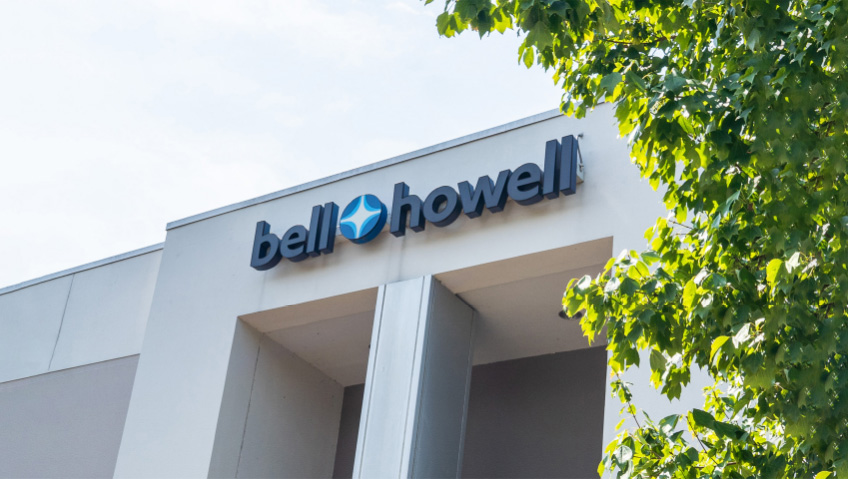Technology-enabled field services company Bell and Howell services a wide range of automation equipment for multiple original equipment manufacturers (OEMs) and markets across North America. We spoke to the company a year ago, reporting on how the Durham, North Carolina-based business helps customers increase efficiency and reduce operational costs through its comprehensive solutions in retail, grocery, pharmacy click-and-collect, automation, and production mail. This month, we sat down with senior executive and grocery commerce expert James Hermanowski to learn more about the company’s work to fight food insecurity through food bank technology.
It all begins with the company’s underlying value system. When asked why Bell and Howell is driven to support food banks, he replies, “I believe that question can be answered by our company philosophy of ‘Doing the Right Thing.’ Doing the right thing is our promise to each other as part of the Bell and Howell family. If we take care of each other, we take care of our customers, take care of the company and our community, we will all be successful.”
Food insecurity is a particularly salient issue in our pandemic world. “The arrival of COVID-19 impacted many parts of the economy,” Hermanowski says. “Unemployment skyrocketed, and food insecurity increased dramatically. Headline news across the country showed videos of hundreds of vehicles lined up to receive boxes of food put together by wonderful teams of volunteers. Adding more pain to the picture, food prices are skyrocketing, items are scarce, and more people are negatively impacted. Many pockets of the population—our neighbors—struggle and juggle the cost of medicine, food, and fuel each day.
“COVID-19 also disproportionately impacted some people at higher risk of severe illness. This includes older adults (65 years and older) and people of any age with serious underlying medical conditions. However, volunteer ranks are heavily weighted toward older adults, many of which have stepped away from volunteering to protect themselves and their families from a potentially devastating infection. In other situations, the concern was too great and the burden too much to bear that organizations took preventive measures and asked at-risk volunteers to stay away.”
There is a clear need for a more flexible system in which people can access food banks on their schedule, without having to rely on volunteers. “The services our neighbors depend upon for nutritious food face a bleak future unless there is change,” Hermanowski says. Food assistance programs “are left understaffed yet need to service an increasing population. Consequently, the open hours available at food access locations have been reduced to the level where there is just no possible way for our neighbors to pick up the food they need. In some communities, it is down to just two hours each week, and unfortunately, those two hours are at a time when many recipients just cannot be there.”
Consumers are not the only ones reeling from the pandemic landscape. COVID-19 has accelerated new grocery trends that the industry must accommodate with little time to adjust. “COVID-19 has also had a dramatic impact on our partners in the grocery space,” he says.
“Online purchasing of groceries has exploded from a small percentage of the total spending pre-COVID to over 10 percent, or $100 billion, in 2021. That trend has not abated with forecast [compound annual growth rate] of 18.1 percent over the next few years reaching $300 billion. Grocers are building the next generation infrastructure to support this tremendous growth with much of it focused on digital and online shopping. Digital investments include better websites optimized for mobile users, digital coupons, digital recipes and the ability to allow consumers to ‘opt in’ so the store can track their arrival using their mobile phone so their order is ready when they arrive.”
Grocery stores must navigate this rapidly evolving landscape while simultaneously dealing with a worker shortage—not unlike the challenge facing food banks. “Grocers also face similar challenges finding people,” Hermanowski says. “They do not rely on volunteers but they, too, find it challenging to hire enough labor to keep grocery stores and their online systems running. However, they have access to technology that helps them overcome these challenges,” he shares.
“One extremely helpful solution employed is known as ‘automated pickup’ technology. Automated pickup technology is equipment that holds a customer’s order for them until they arrive to pick it up. The systems maintain proper temperatures for groceries and do not require a store employee to be there to deliver the order. As a result, consumers are able to pick up their groceries at their convenience even if the store is closed,” Hermanowski explains.
“Like many new technologies, automated pickup systems create new paradigms never considered before. Consider the automated teller machine or ATM. When it first appeared, no one ever thought it would be possible to obtain cash from their bank account anytime day or night. Automated grocery pickup systems are the new ATMs for food.
“The trends are surprisingly clear,” he continues. “The grocery ecosystem is quickly moving in a digital direction where access to computers, mobile phones and the Internet are becoming the minimum requirement to participate. When Amazon first arrived, it offered vast quantities of products, often priced lower online than locally. Those with access to Amazon’s website benefited; those without, paid more. As grocery moves to the digital domain, the same is expected to happen, and the beginnings of that are visible today with many grocers offering ‘digital only’ deals.
“Yet, studies continue to show that households with incomes below $30,000 per year are significantly less likely to have access to broadband services, a computer or a smartphone. Although smartphone availability and use is higher than for a computer, there are many cases where the mobile number changes over time because the user is unable to pay for mobile service for a given month. Furthermore, the keys to grocery’s digital kingdom revolve around a user account, which requires an email address or a mobile phone number, and in many cases, both—something not often available to those suffering from food insecurity. If something is not done promptly, the new digital ecosystem being built by grocers will continue down a path that leaves our neighbors with food insecurity behind.”
Bell and Howell’s ability to leverage a grocer’s own tools can mitigate this digital divide. “Automated grocery pickup systems and the ecosystems to support them are being rolled out by grocers across the United States, making them readily available and produced in economical volumes,” he says.
“Some grocers can and do place the machines in food deserts, supporting communities that would otherwise have no access to a full assortment of healthy foods. Most importantly, deployments are giving communities access to that food at a time and location convenient for them.
“This same technology can be readily deployed to address food insecurity and vendors such as us have partnered with food access programs and others to create features specifically designed to address the needs of our neighbors, for example, the ability to access the technology even without a computer or mobile phone. Innovations like these not only improve food access but level the playing field and reduce the digital divide.”
Typically, automated grocery pickup systems come in two forms, depending on the volume and how often they are used. Grocery ‘PODs’ address high volumes of groceries, while grocery smart lockers, like Bell and Howell’s QuickCollect GL address low to moderate volumes of groceries. Both options are popular with food banks and grocery stores around the country because they provide secure, temperature-controlled environments to safely store groceries until the consumer can collect them.
The Bell and Howell team believes that the use of automated technology will continue to increase in the future. “Non-profit organizations such as Feeding America are addressing hunger across America,” Hermanowski says. “They are expert at acquiring and moving large quantities of food across the nation, serving millions of our neighbors just like any leading grocer, except it is a non-profit organization. We see the same types of technology used by large corporations and grocers to manage customer interactions, improve supply chain efficiency, and run complex organizations making its way into the non-profits that support food access programs.”
Having this technology utilized for non-profit applications to reduce food insecurity across America is certainly welcome news and evidence that Bell and Howell’s ‘Doing the Right Thing’ mentality is at work throughout the nation to create positive, lasting change.






